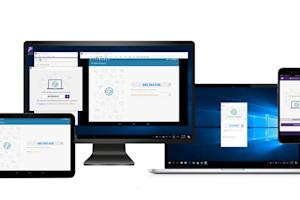Today, many internal IT departments, managed service providers (MSPs), help desk and service desk teams across the globe use Splashtop day-to-day as one of their core tools. With important attributes like robust security, superior user experience, and excellent customer service, Splashtop is a leading solution for remote control and support.
Splashtop Enterprise offers advanced capabilities to improve the support workflow for service desk teams and deliver a better experience not just to the end-users but also the technicians themselves.
Benefits of the Service Desk Capabilities
Increased Technician Efficiency with Powerful Routing and Organization
The technicians who are part of a service desk can be organized according to customers, expertise, skill levels, and so on. Technicians can be organized into groups, incoming user-initiated support requests can be routed via channels, and different technician groups can be assigned to handle different channels. For example, all support requests from the graphics design department that uses Mac workstations exclusively can be routed to a dedicated channel, and that channel can be assigned to a technician group made up of Mac experts. With proper setting of roles, permissions, and granular controls, technicians are granted the minimum privileges needed to accomplish their tasks. Easy configuration of routing and organization results in improved technician efficiency and service level agreements (SLAs).
Faster Resolution with Technician Collaboration
If a troubleshooting session goes beyond the initial technician’s domain of expertise, he/she can easily transfer the support session to another technician or group, or invite other technicians to collaborate on the session Streamlined routing of support sessions helps to get the right technician in place and accelerate the resolution time for the end-user.
Enhanced Customer Support Experience
In order to deliver the best customer support, every second counts. Delivering fast and effective remote support, through efficient processes and tools, increases customer satisfaction. The design of Splashtop Enterprise aims to make the experience easier and faster for all: the end-user, the technician, and the leader of the service desk.
What Are the Features?
The service desk capabilities highlight an improved ad hoc support workflow featuring fast and easy connections, support queue, technician grouping and collaboration, user-initiated support requests, request routing, and more. These features are available with the technician licenses in Splashtop Enterprise.
On-Demand Session Invitation Workflow
Splashtop Enterprise technicians have the option to choose between the invitation link and the traditional on-demand support workflow. With the traditional workflow, technicians direct their end-users to sos.splashtop.com, to download and run the SOS app. That generates a 9-digit session code which the end-user sends back to the technician. The technician then enters that code on his or her end to remote into the end-user device.

Figure 1 - Creating a new support session for Aaron
In the updated workflow, the technician simply generates a support link and sends it to the end-user. The end-user follows the link to download and run a small app. When that is done, the technician will see the ‘ready’ status in the support queue and can initiate the remote session at will.
There is no longer the need for the end-user to pass the session code, as in the traditional support workflow.
The technician can see additional device information such as OS version and IP address, even before connecting in. The end-user will also be prompted to grant permission, thereby fulfilling organizations’ compliance and privacy requirements.
Support Queue
Technicians can see and can work off of a support queue. The support queue shows the support invitations they have sent out, the support requests that have been assigned to them, and end-users who are ready for the technicians to engage. Some of the status of the support sessions in the queue are as follows:
Waiting – Waiting for end-user to follow the support link
Active – Technician has engaged with the end-user
Closed – Support session completed and closed by technician
Expired – End-user did not follow the support link in time

Figure 2 - Technician support queue
Support Channels and Technician Management
A service desk may have the desire to organize technicians by expertise, then have the incoming support requests routed automatically to the appropriate technicians. Splashtop Enterprise makes this possible by allowing the creation of “channels,” which can map to different corporate departments. Technicians can be organized into groups based on their expertise. Each channel can then be configured to automatically route its support requests to the appropriate technician groups or technicians.
Service desk personnel can be assigned specific roles within Splashtop Enterprise, to align with their job responsibilities. For example:
Channel technician – Able to take unassigned support sessions and work the sessions he or she is assigned to; no channel management privileges
Channel manager – Can configure and manage the channels under his or her control; can manage the support sessions in those channels
Technician manager – Can create, configure, and delete channels; can manage the support sessions in all channels and more
In addition, each technician’s privileges related to session management can be granularly defined, as illustrated.

Figure 3 - Granular permission control for technician management
Support Session Transfer and Routing
As needed, technicians can easily transfer a support session to another channel or specific technician, to facilitate resolution of the customer issue. An example might be a tier 1 technician transferring to a tier 2 technician, or a tier 1 technician transferring to a technician group with the right domain expertise. Technicians can also invite multiple technicians to collaborate on the support session.
SOS Call – User Initiated Support Requests and Session Routing
With this feature, users can request a support session through the SOS Call app that can be deployed on their desktops. The session will be routed to the designated channel’s support queue.

Figure 4 – End-user requests a support session through the SOS Call app (left), and the session is routed to the channel’s support queue (right)

Watch a demo
Try out these new features with Splashtop Enterprise today! Contact us to learn more or start a free trial.




